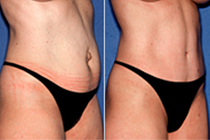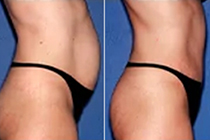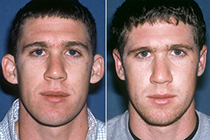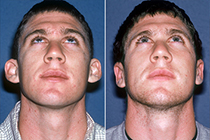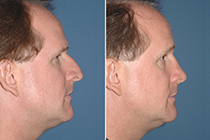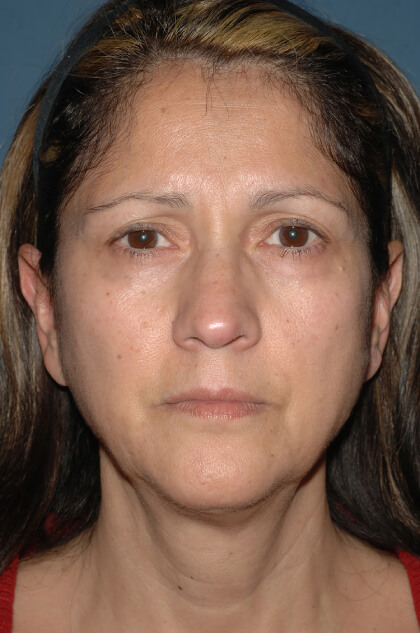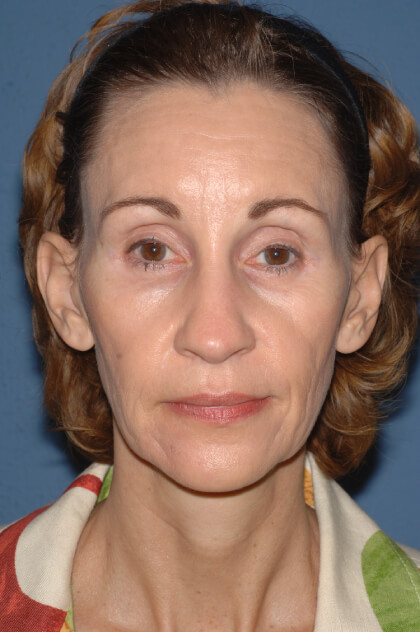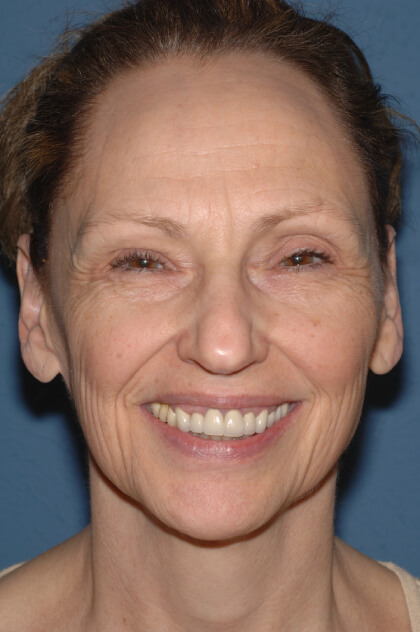Facelift
Conveniently located to serve the areas of Dallas, TX

A facelift, also known as rhytidectomy, is a surgical procedure that aims to improve the visible signs of aging in the face and neck. This procedure can restore youthful contours, rejuvenate sagging skin, and remove deep creases around the nose and mouth.
Dr. Steven J. White is a board-certified plastic surgeon who performs facelift surgery for patients seeking natural-looking and long-lasting results. By incorporating the latest skin-tightening techniques, Dr. White’s facelift tightens underlying facial tissues, removes excess fat, and smooths loose skin on the face and neck. Combined with nonsurgical treatments such as Botox, the results can take a decade or more off of one’s appearance.
If you think you would benefit from a facelift, then take the first step toward facial rejuvenation by scheduling a consultation with Dr. White at USA Plastic Surgery. If you have any questions or would prefer to schedule an appointment over the phone, please call our Dallas office at (214) 833-6751.
Contents
Before and After Photos
About Facelifts
Facelifts are transformative cosmetic surgery procedures designed to enhance your facial appearance and ultimately improve self-confidence. As we age, our skin loses its elasticity, and the fat in our faces shifts, which can lead to drooping and sagging. Genetics, lifestyle choices, and environmental factors can contribute to these changes as well. Facelifts are becoming increasingly common, especially as advanced surgical skills and progressive surgical techniques yield increasingly impressive results. (1) Experienced surgeons understand the anatomy of the face and produce results that are not only lasting but also appear natural. If you are ready to turn back the hands of time and look younger today, we encourage you to call our plastic surgery office and schedule a complete consultation to learn more.
Benefits
Undergoing a facelift surgery offers numerous benefits. At USA Plastic Surgery, our patients see benefits such as:
- More youthful appearance: One of the primary goals of a facelift is restoring a younger, fresher appearance by tightening loose or sagging skin.
- Improved confidence: Many individuals experience enhanced self-esteem after surgery due to their new appearance.
- Long-lasting results: Unlike non-surgical treatments, facelift results are generally long-lasting, often providing benefits for up to 10 years or longer.
- Customizable procedures: Surgeons can tailor procedures to suit individual needs, targeting specific areas for improvement.
- Additional treatments: Facelifts can be combined with other surgeries such as brow lifts or eyelid surgeries for more extensive rejuvenation.
- Reduction of deep wrinkles: The procedure helps smooth out deep lines and folds around the mouth and nose.
- Restoration of facial contours: By redistributing or removing excess fat, surgeons can define the jawline and cheekbones, providing a youthful contour.
- Natural-looking results: Skilled plastic surgeons like Dr. White prioritize natural aesthetics for beautiful results.
Candidates
Good candidates for facelifts are men or women who have loose skin in the middle of their face, on their jawline, and their necks. A loss of volume throughout the face and neck can also be corrected with a facelift. Patients should also be in good overall health before undergoing a facelift. Some exceptions can be made for certain conditions, but all patients should be healthy enough to undergo the operation and recovery without significant complications.
There is no age requirement for a facelift, but it does help to delay until your late 30s or early 40s at the earliest. (1) Younger patients may not have significant wrinkles or loss of mass that will benefit from surgical corrections. For these patients, non-surgical treatments like Botox or dermal fillers may be more beneficial. Finally, patients should maintain realistic expectations for their results and be willing to work with Dr. White to create their ideal treatment plan.
Personal Consultation
Your facelift treatment starts with a personal consultation with Dr. White. During the consultation, we will evaluate your overall health along with skin quality, skin looseness, folds, and wrinkles. In addition, the underlying bone anatomy will be assessed and a facial rejuvenation treatment plan will be created that will help attain the best results. There are several variations of a surgical facelift, including a skin-only lift, which is reserved for patients with less sagging, a mid-facelift, which addresses the cheeks and mid-face area, and for those with severe sagging, a deep-plane lift, which addresses deeper wrinkles and folds.
It is very common to combine nonsurgical techniques with a facelift to maximize results. This may include dermal fillers or Botox, as well as a chemical peel or a laser treatment to address skin irregularities on the surface, such as scars, sunspots, and blemishes.
Your unique facelift will be planned to address your unique anatomy and your needs. If you wish to include any other rejuvenation treatments, please discuss these during your consultation. Your medical history will also be reviewed during this appointment.
Preparation
Following Dr. White’s preparation instructions before your procedure will help ensure satisfying results and an optimized recovery. You may be required to alter your medication regimen, especially if it involves any blood-thinning medications. You will receive a list of things to avoid before your procedure, but please note that you should especially avoid ibuprofen, aspirin, alcohol, and nicotine.
We also recommend preparing a comfortable space at home to recover in. Taking extra steps like making your bed, buying a new pillow, changing your sheets, and more can provide you with extra relief when you return from your procedure. Finally, you are required to arrange transportation to and from your procedure, and this person should plan to stay with you for a few hours after your procedure to monitor your initial recovery.
Procedure
A typical facelift procedure lasts between two and four hours. After the skin and tissue are numbed, Dr. White will make a series of strategic incisions around your face and neck. For most procedures, these are placed near the ears, hairline, and jaw so that they are hidden by your face’s natural contours and your hair. If there is significant skin sagging, then some of this will be removed. Following this, Dr. White will tighten the underlying facial muscles with sutures. (2)
In some cases, facial fat may be redistributed or supplemental autologous body fat will be added to sculpt a healthy and more youthful facial contour. Once Dr. White has completed the planned adjustments, he will take one final examination to ensure facial symmetry and harmony. After this, your incisions will be sutured and you will be treated and dismissed to begin your recovery.
Recovery
Depending on the extent of the facelift and the patient’s overall health, patients may have an overnight stay or be discharged later in the day. Swelling and bruising are expected after facelift surgery. The swelling and bruising will start to resolve during the first week after surgery, although this will vary between patients.
We recommend taking your prescribed medication as instructed, applying cold compresses, and taking light walks to reduce swelling and promote regular blood flow. Most patients can resume modest activity in 2-3 weeks, but more intense activities should be delayed for 5-6 weeks. A complete recovery from a facelift surgery occurs in about 6 weeks. Supplemental procedures, such as nonsurgical skin rejuvenation, can usually be performed at this time.
Results
Facelift results will continue to improve as swelling diminishes over the following weeks. Parts of your face that once had sagging, tired skin and wrinkles will now be smooth, wrinkle-free, and taut. Scars typically fade over time, producing natural-looking results that can last many years. Patients often enjoy restored youthful faces with elevated cheekbones and defined jawlines.
Corresponding & Complementary Procedures

As mentioned above, many non-surgical rejuvenation treatments can help bring the results of your facelift to a new level. One of the most popular of these is botulinum toxin, or as it is more commonly known, Botox. When used alongside a facelift, Botox will typically target wrinkles that are caused by repetitive muscle contraction. Botox works by blocking nerve signals to muscles that cause them to contract. By keeping them in a semi-permanent flexed position, your skin remains smooth.
Many patients may also see some sagging skin around their eyes, which may contribute to an “angry” appearance. Dr. White will often recommend that these patients receive a blepharoplasty, or eyelid surgery. These procedures reduce sagging skin and excess fat from around the eyes to sculpt a new, youthful appearance that enhances the eyes.
Cost of Facelifts in Dallas
Dr. White customizes each procedure to match a patient’s goals and needs. Because everyone’s face is different, facelifts require extra attention to detail and customization. As such, each facelift carries a different price. When you meet with Dr. White for a consultation, you will receive a price quote for your procedure.
If you have any questions about payments, prices, procedures, our practice, or more, please do not hesitate to speak with one of the experts at our Dallas office by calling (214) 833-6751.
FAQ
What is a facelift?
A facelift, or rhytidectomy, is a surgical procedure designed to improve the most visible signs of the aging process by eliminating excess fat, tightening the muscles beneath the skin of the neck, and removing sagging skin. It doesn’t stop the aging process but merely “sets the clock back.”
Do facelifts leave scars?
The scars from facelift surgery usually fade and are barely perceptible. In some patients, especially younger ones, endoscopic surgery can be used to lift the eyebrows, remove frown lines, elevate the cheek and jowls, and tighten the neck. This endoscopic surgery can be done with tiny scars. However, if there is excessive skin, it must be removed for the best results through standard facelift incisions.
How long does a facelift last?
A facelift typically lasts between 10 to 15 years, depending on an individual’s skin type, age, and lifestyle habits.
What is the difference between a facelift and a mini facelift?
A traditional facelift addresses extensive sagging, while a mini facelift involves fewer incisions and is aimed at less pronounced aging.
Can a facelift be combined with other procedures?
Yes, many patients opt for combinations of treatments such as brow lifts or eyelid surgery for comprehensive aesthetic enhancement.
References
- Raggio BS, Patel BC. Deep Plane Facelift. PubMed. Published 2021. https://www.ncbi.nlm.nih.gov/books/NBK545277/
- Kaya KS, Cakmak O. FACELIFT TECHNIQUES: AN OVERVIEW. Facial Plastic Surgery. Published online June 16, 2022. doi:https://doi.org/10.1055/a-1877-9371




